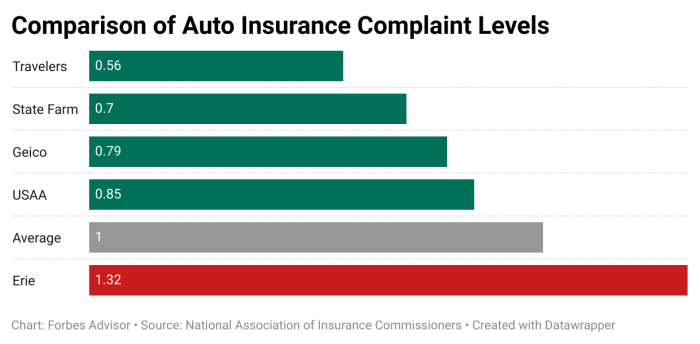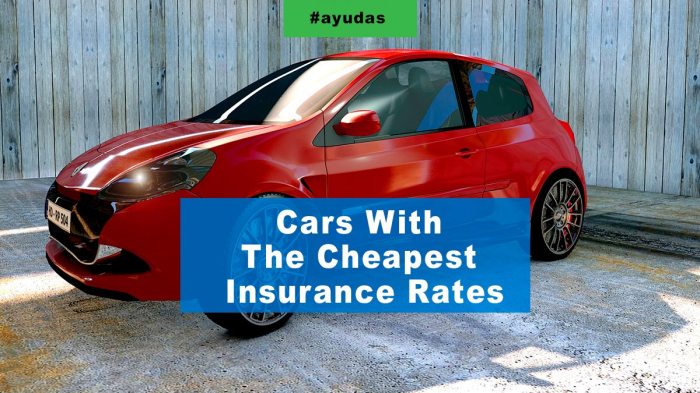The cost of car insurance can significantly impact your budget, making the choice of vehicle a crucial financial decision. Understanding the factors that influence premiums – from the car’s features to your driving history – is key to finding affordable coverage. This guide explores the interplay between vehicle characteristics, driver profiles, and insurance costs, empowering you to make informed choices about both your car and your insurance policy.
We’ll delve into specific car models known for their lower insurance premiums, examining their safety features, fuel efficiency, and overall value proposition. We’ll also compare different insurance providers, highlighting variations in pricing, coverage, and customer service. Ultimately, our aim is to equip you with the knowledge and strategies needed to secure the most cost-effective car insurance without compromising on necessary coverage.
Factors Affecting Car Insurance Costs

Car insurance premiums are influenced by a complex interplay of factors, ultimately reflecting the insurer’s assessment of risk. Understanding these factors can empower you to make informed decisions and potentially lower your insurance costs. This section details the key elements that insurers consider when determining your premium.
Car Features and Insurance Premiums
The characteristics of your vehicle significantly impact your insurance rate. Larger vehicles, often associated with higher repair costs and greater potential for damage, generally command higher premiums. Conversely, smaller cars typically result in lower premiums. Safety features play a crucial role; cars with advanced safety ratings (e.g., high scores from the IIHS or NHTSA) often receive discounts due to their reduced accident risk. Fuel efficiency is also a factor, with more fuel-efficient cars sometimes leading to slightly lower premiums, although this impact is usually less significant than vehicle size and safety features. For instance, a large SUV with a low safety rating will likely have a higher premium than a smaller, fuel-efficient car with advanced safety technology.
Driving History’s Influence on Insurance Costs
Your driving record is a primary determinant of your insurance premium. Accidents and traffic violations significantly increase your risk profile. The severity of the accident (e.g., a fender bender versus a major collision) and the number of at-fault accidents directly impact premiums. Similarly, speeding tickets, reckless driving citations, and DUI convictions drastically raise insurance costs, often resulting in higher premiums for several years. A clean driving record, conversely, is rewarded with lower premiums. For example, a driver with three at-fault accidents in the past five years will face substantially higher premiums than a driver with a spotless record.
Age, Location, and Credit Score Impacts
Age is a significant factor; younger drivers, statistically involved in more accidents, usually pay higher premiums. As drivers age and gain experience, their premiums generally decrease. Location also matters; insurers consider the accident rates and crime statistics in your area. Areas with high accident rates or theft rates will typically have higher insurance premiums. Finally, your credit score, surprisingly, often influences insurance rates. Insurers use credit scores as an indicator of risk, with those possessing good credit often qualifying for lower premiums. A young driver living in a high-crime area with a poor credit score will likely face significantly higher premiums than an older driver with a clean record living in a safer area and possessing excellent credit.
Comparison of Insurance Costs for Different Driver Profiles
The following table illustrates how different driver profiles can impact insurance costs. These are illustrative examples and actual costs will vary depending on the specific insurer and other factors.
| Driver Profile | Age | Driving History | Estimated Annual Premium |
|---|---|---|---|
| Young, Inexperienced Driver | 20 | Clean Record | $1800 |
| Young Driver with Accidents | 22 | 2 at-fault accidents | $2800 |
| Experienced Driver | 45 | Clean Record | $1200 |
| Experienced Driver with Violations | 50 | Speeding ticket | $1500 |
Strategies for Reducing Insurance Costs

Reducing your car insurance premiums requires a proactive approach, combining smart shopping strategies with responsible driving habits. By understanding the factors influencing your rates and implementing these strategies, you can significantly lower your annual costs. This section details practical methods for achieving substantial savings on your car insurance.
Discounts on Car Insurance
Several avenues exist to secure discounts on your car insurance. Insurers frequently offer incentives to reward responsible behavior and encourage bundled services. Taking advantage of these opportunities can lead to considerable savings.
- Bundling Policies: Many insurers provide discounts for bundling your car insurance with other policies, such as homeowners or renters insurance. This demonstrates loyalty and reduces administrative costs for the insurance company, resulting in lower premiums for you. For example, a customer who bundles their car and home insurance might receive a 10-15% discount.
- Safe Driving Courses: Completing a defensive driving course can often result in a discount. These courses demonstrate your commitment to safe driving practices, reducing your risk profile in the eyes of insurers. The discount percentage varies depending on the insurer and the course completed, but savings of 5-10% are common.
- Vehicle Safety Features: Cars equipped with advanced safety features, such as anti-theft systems, airbags, and anti-lock brakes, often qualify for discounts. These features reduce the likelihood of accidents and associated claims, leading to lower premiums. A car with advanced safety features might receive a 5-10% discount.
- Good Student Discounts: Students maintaining a high GPA may be eligible for discounts. Insurers recognize that high-achieving students tend to be more responsible, leading to a lower risk profile. A good student discount could range from 5-25% depending on the insurer and the student’s academic performance.
Impact of Increased Deductibles on Premiums
Increasing your deductible—the amount you pay out-of-pocket before your insurance coverage kicks in—directly impacts your premium. A higher deductible means a lower premium, as you’re assuming more of the financial risk. Conversely, a lower deductible results in a higher premium. It’s crucial to find a balance between affordability and the ability to cover a potential deductible in the event of an accident. For instance, increasing your deductible from $500 to $1000 could result in a 15-20% reduction in your premium, but you would need to be prepared to pay $1000 out of pocket before your insurance covers any further costs.
Improving Your Driving Record
Maintaining a clean driving record is paramount for securing lower insurance rates. Accidents and traffic violations significantly increase your premiums. Improving your driving record involves focusing on safe driving practices and avoiding infractions.
- Avoid Accidents: The most impactful way to lower your premiums is to avoid accidents. Accidents significantly increase your risk profile and lead to higher premiums for several years following the incident.
- Minimize Traffic Violations: Traffic violations like speeding tickets and reckless driving significantly raise your insurance rates. Practicing safe and responsible driving habits will keep your record clean and your premiums low.
- Consider a Driving Record Improvement Program: Some states offer programs to help drivers improve their driving records and potentially lower their insurance premiums.
Effective Car Insurance Shopping and Quote Comparison
Shopping for car insurance involves comparing quotes from multiple insurers. This allows you to identify the most competitive rates and coverage options that best suit your needs.
- Use Online Comparison Tools: Many websites allow you to compare quotes from various insurers simultaneously. This simplifies the process and ensures you’re not missing out on better deals.
- Contact Insurers Directly: Don’t rely solely on online comparisons. Contact insurers directly to discuss your specific needs and explore potential discounts. Sometimes, direct contact can uncover deals not readily apparent through online tools.
- Review Policy Details Carefully: Before committing to a policy, carefully review all the terms and conditions, including coverage limits, deductibles, and exclusions.
Epilogue

Choosing a car with lower insurance premiums doesn’t mean sacrificing safety or performance. By carefully considering the factors Artikeld in this guide, including vehicle characteristics, driving history, and insurance provider options, you can effectively manage your insurance costs. Remember, proactive measures like maintaining a clean driving record and shopping around for insurance quotes can yield substantial savings over time. Driving smart and insuring wisely are key to long-term financial health.
Commonly Asked Questions
What is a good credit score for car insurance?
Generally, a credit score above 700 is considered good and can qualify you for lower premiums. Scores below 600 often lead to higher rates.
Can I get car insurance without a driving history?
Yes, but it will likely be more expensive. Insurance companies will use other factors like your age and location to assess risk.
How often should I shop for car insurance?
It’s advisable to compare quotes annually, or even more frequently if your circumstances change (e.g., moving, getting married, adding a driver).
Does my car’s color affect insurance premiums?
While some studies suggest a slight correlation between color and accident rates, most insurers don’t directly use car color to determine premiums.